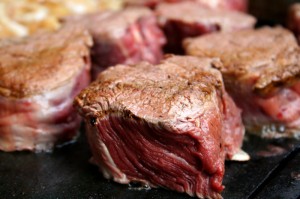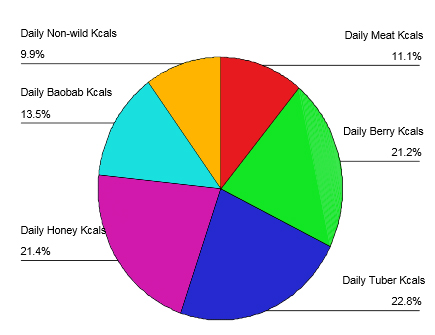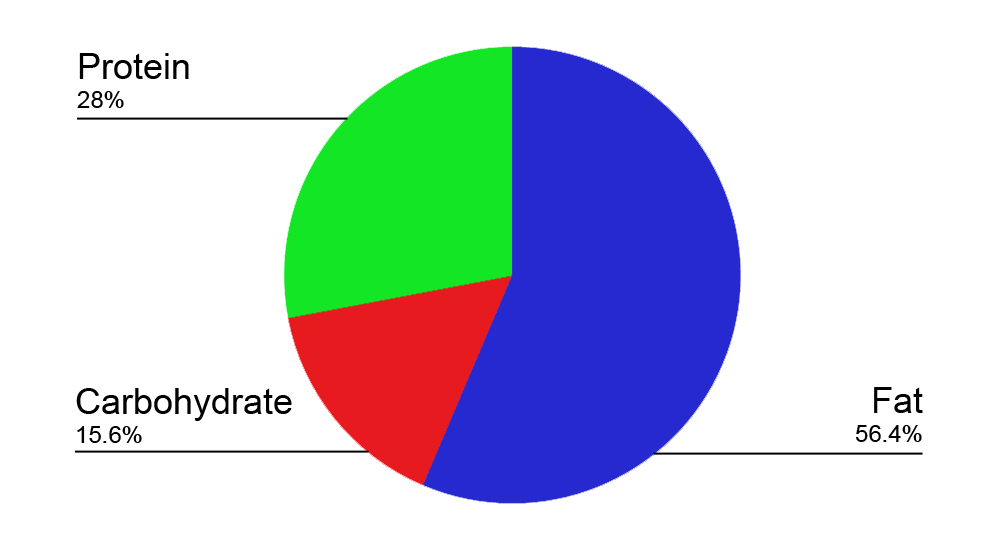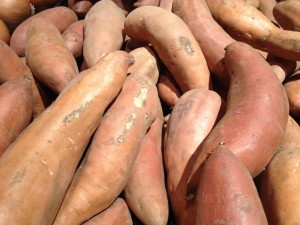Contents
- 1 The paleo diet
- 2 Finding the true paleo diet
- 3 True Paleolithic diet – The Hadza
- 4 What does this tell us?
- 5 How does this compare to ‘modern paleo’?
- 6 What do other tribes eat?
- 7 More problems with ‘modern paleo diets’
- 8 Is the modern paleo diet healthy?
- 9 So, should we eat like the Hadza?
- 10 Digestive differences
- 11 Final thoughts
Following a hunter gatherer diet, and even exercising in a similar fashion as a hunter gatherer, is what our body is designed to do, and so should be the healthiest thing we can do for ourselves. This idea is widely accepted amongst many experts as true, and has lead to the rise of the ‘paleo diet’, which is supposedly based on the diet we ate in the paleolithic period where we lived as hunter gatherers. I’ve decided to research how accurate the popular paleo diet is to the true paleo diet. Did we really eat so much meat?
The paleo diet
The basic diet for the paleo diet contains lots of healthy fats and protein, and limited carbohydrates. The only carbohydrates should be sourced from vegetables, nuts, a small amounts from fruit and absolutely no grains.
 Here is an example of what a modern paleo diet consists of on a daily basis:
Here is an example of what a modern paleo diet consists of on a daily basis:
- Breakfast: Eggs and vegetables, fried in coconut oil.
- Lunch: Chicken salad with olive oil. Handful of nuts.
- Dinner: Steak with vegetables and sweet potatoes.
Obviously the meat, vegetables and fruit will all change around daily, and this is very basic, but its a very clear and representative of what a modern paleo diet is. High in fat, high in protein, lots of vegetables, some nuts and little else.
Finding the true paleo diet
When trying to find the true paleo diet, there is a major problem – there is no one diet which represents a true the human diet from the palaeolithic era. During the paleolithic period the human race was all over the globe, and the diets of the ‘paleo-Inuits’ would be very different from ‘paleo-Africans’. The idea that there was one diet which the human race followed from this era is incorrect. However, it is quite unlikely that people from the modern Western world originate from the populations in extreme climates such as the Arctic. These communities are rather isolated, and there is evidence to suggest that they have not expanded.
There is evidence that we, the Europeans and North Americans, have originated from Africa, and so, in theory, our diets should represent that of humans who inhabited Africa in the palaeolithic era.
True Paleolithic diet – The Hadza
 We are in luck. Currently in Africa there is still an isolated hunter gatherer tribe called the Hadza. The Hadza have no domesticated animals, no farming, and live as true hunter gatherers in an environment which is not significantly influenced by modern society. They do not have markets, or any access to modern processed food. The Hadza truly are real hunter gatherers.
We are in luck. Currently in Africa there is still an isolated hunter gatherer tribe called the Hadza. The Hadza have no domesticated animals, no farming, and live as true hunter gatherers in an environment which is not significantly influenced by modern society. They do not have markets, or any access to modern processed food. The Hadza truly are real hunter gatherers.
If we look at the diet of the Hadza, we can get a very good idea of what a true hunter gatherer diet really looks like. Fortunately, the value of the Hadza diet as an insight into our ‘true’ diet has not gone unnoticed over the years, and has been documented in varying amounts of detail since the 1900’s. Here are some observations of the Hadza diet over the years:
German Geographer (1911) – No farming of any sort seen. The primary diet of the Hadza was tubers, berries, hyrax (small furry animal), baobab, gazelle, antelope, ostrich and giraffe. During the dry season they would hunt at night around water sources. In the wet season they would follow game for many days, and go weeks without a big game kill.
British colonial district officer (1917-1923) – No farming or any domesticated animals. They primarily eat meat, honey, fruit, tubers, fish, snakes, lizards, carrion birds, eggs, ants, insects. They would sometimes kill an elephant for meat.
British colonial game ranger (1945-1947) – Hadza ate baobab as the main food for 5 months. They also ate roots, fruits, honey, and various meats such as rhino when they could.
Fosbrooke (1956) – The diet of the Hadza was mainly fruits such as baobab. They also smoked intoxicating plants.
Barnicot et al (1958 )- By weight, ~80% of their diet was made up of vegetable matter, and ~20% from meat and honey (but account for more calories than that).
McDowell (1980-1981)- Meat was eaten 64% of days, and honey was eaten 21% of the days. They ate 8 different types of roots, and 10 types of berries along with various other fruit. The meat consumption was 0.82kg/ person when meat was available.
Blurton Jones, Hawkes and O’Connell (1982 – over many trips)- Diet mainly consisted of tubers, honey, meat, baobab and berries. By day they used ‘encounter hunting’ and by night they used ‘intercept hunting’ for meat.
Marlowe (1995-1996) – Food brought into camp in order of importance: tubers, berries, honey, baobab, meat. The pie chart below shows the calorie sources of the Hadza during this period (click to enlarge). The 9.9% Kcals labelled ‘non-wild’ Kcals are foods which they have obtained through trading or other methods which are not considered to be hunted or gathered. This graph represents about 70% of the calories they consumed, as 30% of the daily calories are consumed whilst out of the camp during hunting/ foraging. This missing 30% is likely to be various berries and fruits.

What does this tell us?
From this information, it looks like meat was a high priority (and why not, it tastes great, and is high in calories), but was not eaten every day (let alone several times a day as the modern paleo diet would suggest). From this data, meat looks to have been eaten 4-5 times a week (McDowell) and around 10% of their average daily calories came from meat (Marlow and Barnicot et al). A vast amount of their daily calories would have come from carbohydrates from the honey/ fruit/ roots, which were eaten regularly.
It’s fair to say that carbohydrates made up the vast majority of the energy of the Hadza. Fat and protein combined made up around 10% of their average daily calories. Perhaps on a day where they had a big game kill, meat would have made up a much larger portion of their daily calories, but on average, it made up quite a small amount.
How does this compare to ‘modern paleo’?
Lets look at the macro nutrients of a popular ‘modern paleo’ advocate (see pie chart). Calories from fat makes up over 56% of the daily calories, and carbohydrates make up just over 15%. Compare this to to the Hadza calories, where I would think over 70-80% of the calories are from carbohydrates (based on observations by Marlowe), you can see that what some people say is a paleo diet, is quite different from a true paleo diet.
What do other tribes eat?
The Hadza are thought to be the best representation of our ancestral diet, but if you think they are an unfair representative of tribal life, we can look at other isolated tribes to see how much meat they ate.
According to the paleoanthropologist Alison Brooks, “No one eats meat all that often, except in the Arctic“. The cultures, who follow a hunter gather lifestyle all rely on plant foods for up to around 70% of their calories:
- Kung of Botswana traditionally rely on tubers and mongongo nuts
- Aka and Baka Pygmies of the Congo River Basin on yams
- Tsimane and Yanomami Indians of the Amazon on plantains and manioc
- Australian Aboriginals on nut grass and water chestnuts
Aside from the Inuits, who we have not evolved from, plants made up a massive amount of our ancestral diet.
More problems with ‘modern paleo diets’
 One of the cornerstones of the modern paleo diet is that idea that we have only started to eat dense carbohydrates food, especially grains, since agriculture established roughly 10,000 years ago. Not eating these high carbohydrate foods only left meat and vegetables to eat, which are the basic foods for the modern paleo diet. However, Amanda Henry, a paleobiologist, has found “starch granules from plants on fossil teeth and stone tools, which suggests humans may have been eating grains, as well as tubers, for at least 100,000 years”. This evidence supports the idea that the Hadza diet is an accurate representation of the true paleo diet, and contradicts advocates of the ‘modern paleo diet’, who claim starchy foods have only been introduced within the last 10,000 years.
One of the cornerstones of the modern paleo diet is that idea that we have only started to eat dense carbohydrates food, especially grains, since agriculture established roughly 10,000 years ago. Not eating these high carbohydrate foods only left meat and vegetables to eat, which are the basic foods for the modern paleo diet. However, Amanda Henry, a paleobiologist, has found “starch granules from plants on fossil teeth and stone tools, which suggests humans may have been eating grains, as well as tubers, for at least 100,000 years”. This evidence supports the idea that the Hadza diet is an accurate representation of the true paleo diet, and contradicts advocates of the ‘modern paleo diet’, who claim starchy foods have only been introduced within the last 10,000 years.
It looks like the modern paleo diet is based on little more than the idealistic picture of a muscle clad caveman hunting a woolly mammoth and feasting on gigantic chicken drumsticks.
Is the modern paleo diet healthy?
Whilst I am not a supporter of any fad diet, the modern paleo diet is nowhere near as bad other fad diets I have seen such as ‘The Cabbage Soup Diet’. The modern paleo diet does have focus on nutrition, with the emphasis on eating natural foods and minimising processed foods. So it certainly is healthier than all other fad diets I have seen, however, its focus on consuming large amounts of meat, particularly red meat, poses potential health problems.
There is evidence (admittedly limited evidence) that L-carnitine is metabolised by our microflora into TMAO which increases plaque in arteries – increasing the risk of heart disease. Red meat, as well as many sea foods, is very high in L-carnitine, and so regularly consuming these foods in large quantities may well increase the risk of cardiovascular disease. Red meat also has been shown to promote the growth of pathogenic bacteria in the digestive system, and interestingly, seems to promote the growth of those bacteria responsible for TMAO production. Red meat also contains a sugar called Neu5Gc, which stimulates an immune response which leads to inflammation (which is associated with the development of a whole host of diseases). There are health risks associated with eating large amounts of red meat.
So, should we eat like the Hadza?
Don’t go raiding the kitchen for honey and handfuls of fruit just yet. Although the Hadza and similar tribal communities ate large amounts of carbohydrates and simple sugars, you need to remember that you are not a hunter gatherer. Sure, you will largely have hunter gatherer genetics, but you do not live a hunter gatherer lifestyle. Do you spend hours and hours picking fruit/ hunting animals, or do you sit at a desk most of the day, with little or no exercise?
The Hadza can enjoy high energy food and simple sugars, because they are constantly exercising and are using a lot of energy. You on the other hand, will need to control the intake of carbohydrates, especially simple carbohydrates, to avoid health problems. The Hadza diet can be seen as a blueprint for our modern diet which you can build upon, but not a strict guide.
Digestive differences
A potential problem both with following the Hadza diet and the modern paleo diet (if the founding ideas were correct, but they aren’t), is that the bacteria which inhabit our digestive system are very different from that of a hunter gatherer, and I mean very different.
The bacteria in our gut are responsible for moderating our immune system, helping with digestion and ensuring gut health. The population of bacteria you currently host formed from your modern diet and lifestyle, and thrive (for good or for bad) in with a modern diet. Who is to say what would happen if we ate an ancient hunter gatherer diet with modern bacteria? It may not be as healthy as we had thought.
Final thoughts
The modern paleo diet is the latest diet in a long line of fad diets, and doesn’t represent our true palaeolithic diet. This isn’t to say that it doesn’t have its advantages though. The emphasis on vegetables and avoiding processed foods will be a great improvement on the typical diet of someone living in the Western world, where sugary drinks/ snacks are consumed in abundance. However, our body is not naturally designed to consume so much meat, and so there are still potential health risks to the modern paleo diet. If you want to follow a truly natural paleo diet, you could follow the meat eating habits of the Hadza, who would not eat every day, but when they did eat meat, they had a large portion.
We, as modern humans, are in a nutritional grey area. Our genetics are 99% hunter gatherer, yet we have a modern lifestyle and modern digestive system. Our genetics cannot be changed to suit the modern diet, and gut micro flora cannot be changed to allow us to eat as hunter gatherers.

